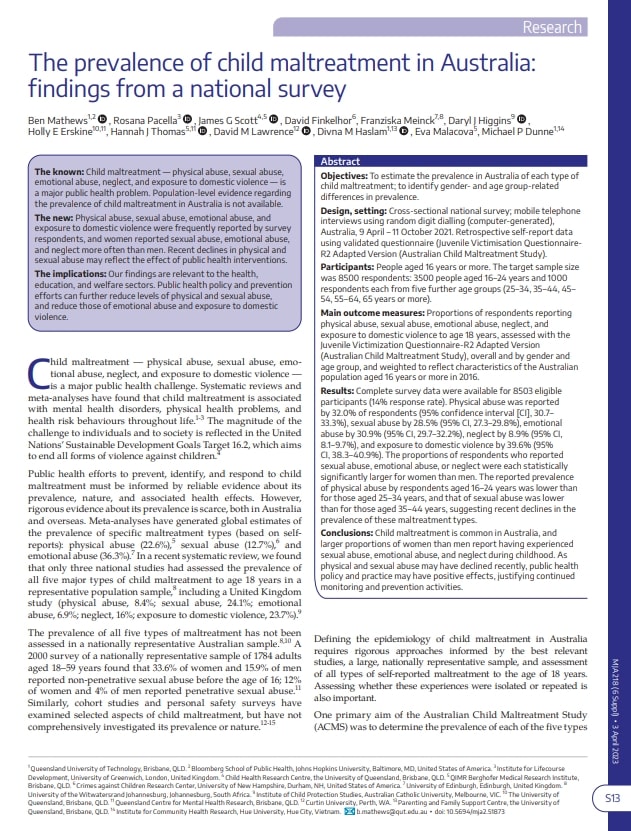The prevalence of child maltreatment in Australia: findings from a national survey.
This key paper outlines the first nationally-representative prevalence rates of all five types of child maltreatment in Australia. It was published in the Medical Journal of Australian ACMS Supplement.
Abstract
Objectives: To estimate the prevalence in Australia of each type of child maltreatment; to identify gender- and age group- related differences in prevalence.
Design, setting: Cross- sectional national survey; mobile telephone interviews using random digit dialling (computer- generated), Australia, 9 April – 11 October 2021. Retrospective self- report data using validated questionnaire (Juvenile Victimisation Questionnaire- R2 Adapted Version (Australian Child Maltreatment Study).
Participants: People aged 16 years or more. The target sample size was 8500 respondents: 3500 people aged 16– 24 years and 1000 respondents each from five further age groups (25– 34, 35– 44, 45– 54, 55– 64, 65 years or more).
Main outcome measures: Proportions of respondents reporting physical abuse, sexual abuse, emotional abuse, neglect, and exposure to domestic violence to age 18 years, assessed with the Juvenile Victimization Questionnaire- R2 Adapted Version (Australian Child Maltreatment Study), overall and by gender and age group, and weighted to reflect characteristics of the Australian population aged 16 years or more in 2016.
Results: Complete survey data were available for 8503 eligible participants (14% response rate). Physical abuse was reported by 32.0% of respondents (95% confidence interval [CI], 30.7– 33.3%), sexual abuse by 28.5% (95% CI, 27.3– 29.8%), emotional abuse by 30.9% (95% CI, 29.7– 32.2%), neglect by 8.9% (95% CI, 8.1– 9.7%), and exposure to domestic violence by 39.6% (95% CI, 38.3– 40.9%). The proportions of respondents who reported sexual abuse, emotional abuse, or neglect were each statistically significantly larger for women than men. The reported prevalence of physical abuse by respondents aged 16– 24 years was lower than for those aged 25– 34 years, and that of sexual abuse was lower than for those aged 35– 44 years, suggesting recent declines in the prevalence of these maltreatment types.
Conclusions: Child maltreatment is common in Australia, and larger proportions of women than men report having experienced sexual abuse, emotional abuse, and neglect during childhood. As physical and sexual abuse may have declined recently, public health, policy and practice may have positive effects, justifying continued monitoring and prevention activities.
Suggested citation
Mathews B, Pacella RE, Scott JG, Finkelhor D, Meinck F, Higgins DJ, Erskine HE, Thomas HJ, Lawrence D, Haslam DM, Malacova E, Dunne MP. The prevalence of child maltreatment in Australia: findings from a national survey. Med J Aust 2023; 218 (6 Suppl): S13-S18. https://doi.org/10.5694/mja2.51873.
